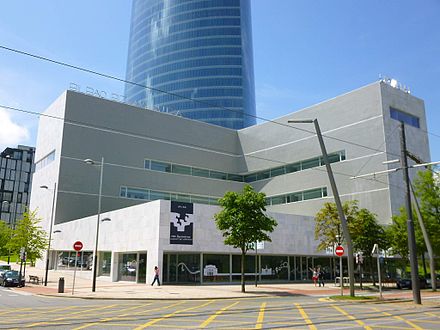The University of the Basque Country (Basque: Euskal Herriko Unibertsitatea, EHU; Spanish: Universidad del País Vasco, UPV; UPV/EHU) is a Spanish public university of the Basque Autonomous Community.
Heir of the University of Bilbao, initially it was made up of the Faculty of Economic and Business Sciences of Sarriko (1955), Medicine (1968) and Sciences (1968). Following the General Law of Education (1970), the Nautical School (1784), the School of Business Studies of Bilbao (1818) and the Technical Schools of Engineers (1897) joined in, until it grew into the complex of thirty centers that compose it presently.
It has campuses over the three provinces of the autonomous community: Bizkaia Campus (in Leioa, Bilbao, Portugalete and Barakaldo), Gipuzkoa Campus (in San Sebastián and Eibar), and Alava Campus in Vitoria-Gasteiz. It stands out as the main research institution in the Basque Country, carrying out 90% of the basic research carried out in that territory and benefiting from the good industrial environment in the region.
The current rector is Eva Ferreira, full professor of applied economics, since 2021.[2][3]

Although there have been numerous institutes of learning in the Basque Country over the centuries, starting with the Universidad Sancti Spiritus de Oñati, it was not until the 20th century that serious efforts were made to create an official university for the Basque people. The first of these opened its doors in Bilbao in 1938, largely thanks to the zeal of the Basque president (lehendakari) at the time, José Antonio Aguirre, an alumnus of the University of Deusto. However, this was during the Spanish Civil War, and an inopportune moment to open a centre of learning. The northwest of the Basque region mostly sided with the Republican movement at this time, earning the wrath of General Francisco Franco. Thus, when Franco's armies entered Bilbao on the 19th of June 1937, the fledgling university was shut down.
It was not until 1968 that another university in the Basque region was founded. In this year, the University of Bilbao was opened. In 1972, the Leioa premises were finished. They were in a remote place among cultivated fields. As in the case of the Somosaguas campus of the Complutense University of Madrid, the dictatorial authorities wanted to keep the rebellious students away from urban areas. In 1977, additional campuses sprang up in Álava and Gipuzkoa. Finally, in 1980, the university was officially designated to be the University of the Basque Country.
As of 2005, 78 different degrees are offered, and the university's 48,000 students can choose from more than 1,300 subjects of study. One can study 90% of the courses in the Basque language.[4] The university is now recognised as one of the foremost in Spain, both in terms of the number of degrees offered and the quality of the typical degree awarded.
In 2009 the UPV/EHU project "Euskampus", was labeled as "Campus of International Excellence", highest quality award by the Spanish Minister of Education. The project has been designed with the aggregation of two important international players: Tecnalia Research and Innovation Corporation and Donostia International Physics Center Foundation.
The current rector is Eva Ferreira. Former rectors:
The motto of UPV/EHU is a Basque-language verse Eman ta zabal zazu ("Give and distribute [the fruit]"), from Gernikako Arbola, a Basque anthem from the 19th century.
The emblem of UPV/EHU is an interpretation of the Guernica oak by sculptor Eduardo Chillida.[5]
One of the characteristics of the university is the dispersion of its faculties and schools. The university contains three campuses, one for each of the three provinces of the Basque Autonomous Community.

Biscay Campus is the largest and the busiest campus; its main complex is in Leioa, eleven kilometres away from Bilbao's city centre, in the seat of the former University of Bilbao. Nonetheless, there are other centres and schools within Bilbao, in Barakaldo and in Portugalete. Since 2011, the university also has a representation centre, the Bizkaia Aretoa, in the Abandoibarra neighbourhood of Bilbao, which houses some of the university's offices but also congresses and expositions.


Gipuzkoa Campus is seated in San Sebastián and Eibar. In San Sebastián, faculties and schools that used to be spread out in the city have been grouped together in the neighbourhood of Ibaeta.
_4.jpg/440px-Vitoria_-_Facultad_de_Ciencias_de_la_Actividad_Física_y_el_Deporte_(UPV-EHU)_4.jpg)
Álava Campus is seated in the south of Vitoria-Gasteiz:
The Master and Doctoral School is responsible for coordinating and managing doctoral programmes and interdisciplinary research training, as well as coordinating and managing official master's degrees, with exception of those with professional attributes. It is common to the three campuses.
There are five schools affiliated with UPV/EHU:
UPV/EHU conducts its Summer Courses, created in 1981, at the Miramar Palace in San Sebastián. They consist of a series of lectures, talks, courses, and master classes on diverse subjects from different areas of knowledge. World-renowned lecturers have been invited to the Summer Courses, as for example, Noam Chomsky in 2006.
UPV/EHU has an important handball team. The university also has a football team that played in the Spanish Tercera División, Grupo 4 in the 2006–2007 season. They finished 19th and were relegated to the regional divisions.
The Engineering School of Bilbao and the University of Deusto hold yearly rowing competitions on the Estuary of Bilbao, inspired by the Oxford Cambridge boat race.
The University used to offer an English language, distance Postgraduate Diploma in International Election Observation and Electoral Assistance, the first official postgraduate qualification of its kind that provides advanced learning in electoral systems and electoral campaign processes, with a particular focus for those occurring in contexts of developing democracies or post-conflict situations. The programme was allegedly run in cooperation with many organisations in the field of election monitoring, such as The Carter Center, Electoral Reform International Services (ERIS), International Foundation for Electoral Systems (IFES), National Democratic Institute (NDI), the Organization of American States (OAS) and the OSCE Office for Democratic Institutions and Human Rights (ODIHR) but such partnerships were not officially confirmed.[10]